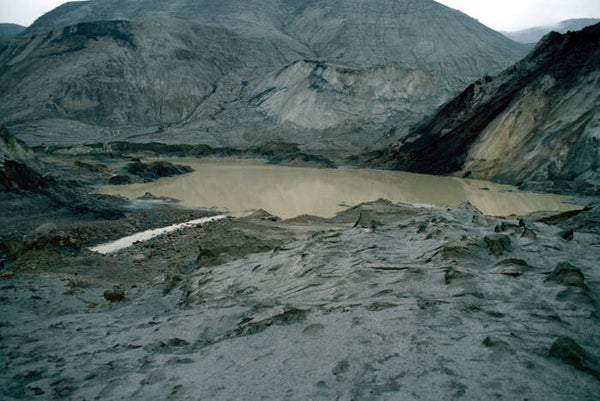This article was published in Scientific American’s former blog network and reflects the views of the author, not necessarily those of Scientific American
Here's a fascinating mini geostory:
Jackson Creek was dammed by the May 18, 1980 debris avalanche. Water began backing up, forming a newborn lake—much like what happened at Coldwater Creek and Castle Creek. Numerous other ephemeral lakes formed in the same way, but many of them perished during the summer of 1980. Unfortunately, debris avalanches don't make the best dams. Water easily "overtopped, downcut, and breached" the unconsolidated rock and soil that had spilled willy-nilly down the North Fork Toutle River valley. The floodwater picked up loose volcanic debris as it rushed through the channel, eroding more impoundments on its way downstream and seriously screwing up the containment structure the Army Corps of Engineers were building to try to control flooding and keep the Cowlitz and the Columbia from silting up.
Something had to be done quickly, or worse would happen.
On supporting science journalism
If you're enjoying this article, consider supporting our award-winning journalism by subscribing. By purchasing a subscription you are helping to ensure the future of impactful stories about the discoveries and ideas shaping our world today.
Jackson Lake was perilously close to the North Fork Toutle River. Chances of the waters overtopping and breaching their natural dam were high, and all that water suddenly spilling down the Toutle would wreak worse havoc on the N1 sediment retention structure than the other, smaller breaches had, not to mention damage it would cause to the communities below. So in September of 1980, the Engineers went to work. They cut outlet channels into the debris avalanche deposits damming Jackson and Spotted Buck creeks, allowing the rising waters to drain at a safe and controlled pace. The operation completely drained the infant Spotted Buck lake, and lowered the level of Jackson Lake to safe and manageable levels.
You can see the trench they dug at Jackson Lake if you look closely at this photograph. That humble little trench did a great job saving property, commercial waterways, and perhaps even lives.
Jackson Lake is no more. In the second winter of the young lake's life, the meandering North Fork Toutle River, swollen by storms, eroded through the debris dam: it was fully breached on February 20th, 1982. Sediment carried by the river flooded the baby lake and sent its waters out through the outlet channel. Nearly 2,000 acre feet of water backed up behind the debris avalanche deposit went boisterously sailing down the river, and Jackson Lake ended its existence just short of its second birthday.
Thanks to the Engineers' hard work, the death of the lake was barely a blip downstream. Part of the N1 sediment retention structure was breached by floodwaters that afternoon, and a considerable amount of sediment was swept down the valley, but damage was minimal to non-existent elsewhere. The lowering of the lake less than 18 months before had done its job.
This tiny, short-lived lake is a perfect example of a volcano's power to create and a river's power to destroy. This same drama gets played out the world over, as volcanoes dam waterways, and water erodes the dams, setting the new lakes free. It can happen in months, or, like Silver Lake, it can take millennia. Over geologic time, nothing is forever. It's rather neat when nature shows us how it's done within the span of human time.
References:
Dinehart, Randal L. (1998): Sediment Transport at Gaging Stations near Mount St. Helens, Washington, 1980-90, Data Collection and Analysis. U.S. Geological Survey Professional Paper 1573
Rosenfeld, C.L., and Beach, G.L. (1983): Evolution of a drainage network Remote sensing analysis of the North Fork Toutle River, Mount St. Helens, Washington. Corvallis, Oregon, Water Resources Research Institute, Oregon State University, Final Technical Completion Report, Grant No. 14-34-0001-1452, WRR1-88, 89 p.
United States. Army. Corps of Engineers. (1984): Spirit Lake permanent outlet near Mount St. Helens, alternative strategies: environmental impact statement.
